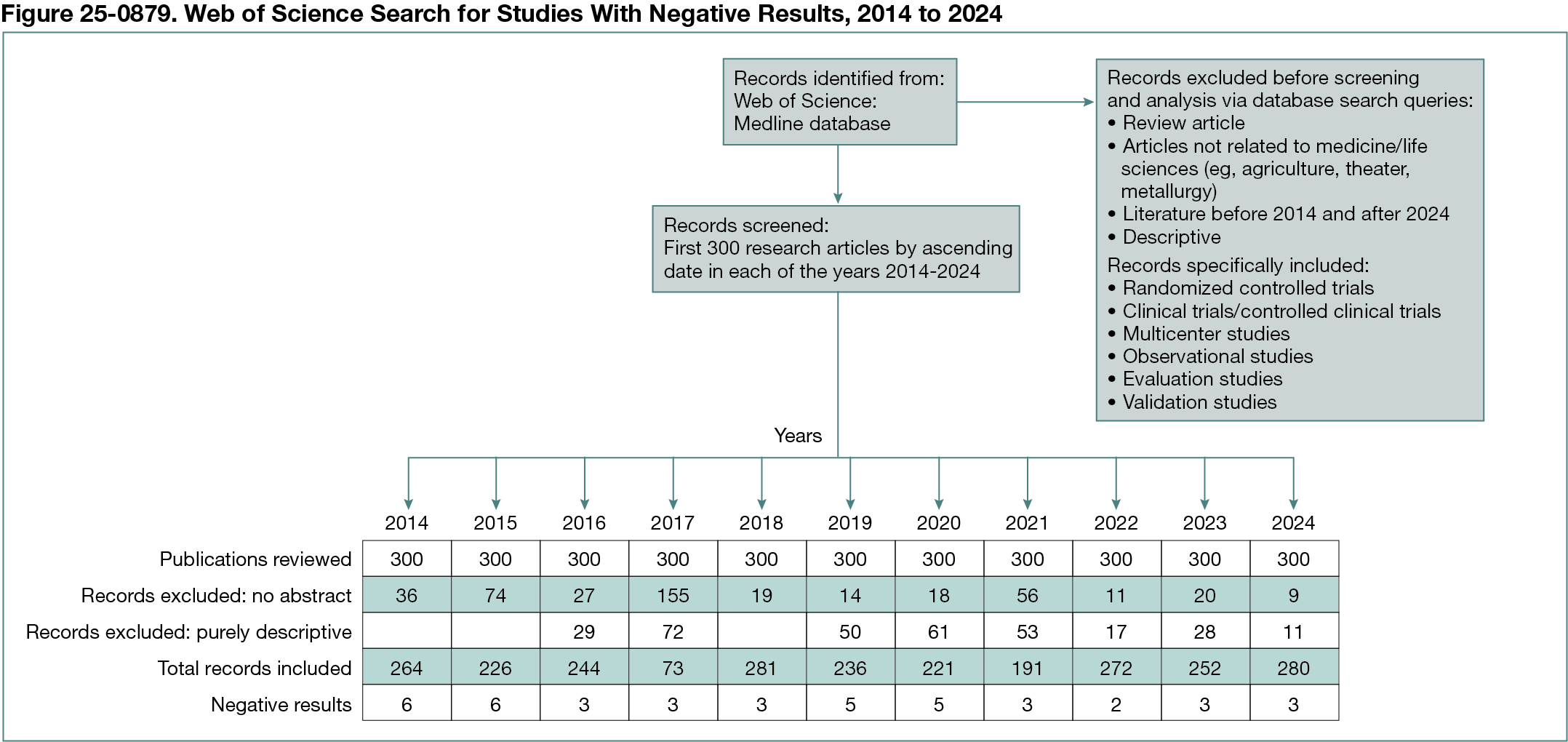Abstract
Biomedical Studies Published With Negative Results Over the Past Decade
Hannah Grace Varkey,1 Florian P. Thomas,1,2 Elli Gourna Paleoudis3,4
Objective
Current scientific practices and culture are largely focused on producing high numbers of publications and positive or newsworthy data. Recently, some journals have dedicated space to the publication of negative results; nevertheless, negative results often remain unpublished, leading to duplication of efforts, lack of transparency, and publication bias. To investigate the evolution of negative data publications over a decade, we reviewed published studies that did not reach statistical significance or reported inconclusive findings or trends.
Design
We searched for negative results in 300 publications per year from 2014 to 2024 using Web of Science’s Medline. To limit selection bias, we selected the first 300 articles of each year based on the Web of Science publication date in chronological order, without regard to the scientific or treatment area. Additional requirements included clinical trial or other experimental design, presence of an abstract, and English language; case reports, commentaries, editorials, and case series were excluded. Records from each year were reviewed independently by 2 researchers to ensure reliability and accuracy. Any disagreements were resolved by a tie-breaking third researcher.
Results
Over 10 years, we found 2 to 6 articles annually (Figure 25-0879) with solely negative results, with a downward trend (from 6 in 2014 to 3 in 2024). This assessment was applied to the primary outcome measure if and as identified. For the purposes of this project, negative results were defined as results that were inconclusive (ie, they did not prove a hypothesis or yield unexplained outcomes) or statistically nonsignificant based on the predefined measure of statistical significance (usually a P value). Identified articles with negative outcomes were most commonly from the fields of cellular biology, biomechanics, and genetics.
Conclusions
Recently, there has been increased attention to and support for publishing negative findings in traditional and new scientific journals and search engines (eg, BioNØT1) focused specifically on these results. The notion that all research, regardless of outcome, can contribute to scientific advancement is gaining traction among journal editors, funders, and the scientific community overall.2 This is particularly true in the artificial intelligence and machine learning era, where models are created based on existing (ie, published) data and research is driven by large datasets.3 Access to negative results would not only limit duplication of effort but also improve planning and interpretation of data. Thus, it may be surprising that publications with negative data remain few in number, and such results are often rejected by journals, forgotten as unpublished data, or buried in supplemental sections.
References
1. Agarwal S, Yu H, Kohane I. BioNØT: a searchable database of biomedical negated sentences. BMC Bioinformatics. 2011;12(1):420. doi:10.1186/1471-2105-12-420
2. Sansom O, Bogani D, Reichenbach L, Wells S. Negative equity—the value of reporting negative results. Dis Model Mech. 2024;17(8):dmm050937. doi:10.1242/dmm.050937
3. Taniike T, Takahashi K. The value of negative results in data-driven catalysis research. Nat Catal. 2023;6:108-111. doi:10.1038/s41929-023-00920-9
1Department of Neurology, Hackensack Meridian School of Medicine, Nutley, NJ, US; 2Hackensack University Medical Center, Nutley, NJ, US; 3Investigator Initiated Research Program and Support Services, Office of Research Administration, Hackensack Meridian Health Research Institute, Nutley, NJ, US; 4Department of Medical Sciences, Hackensack Meridian School of Medicine, Hackensack Meridian Health, Nutley, NJ, US; elli.gournapaleoudis@hmhn.org.
Conflict of Interest Disclosures
None reported.

